The following introduces some pavilions expected to draw attention at the 2025 World Exposition in Osaka.
Austria pavilion to feature music under theme "composing" future
With the country producing great composers like Mozart and Schubert and being home to the Wiener Symphoniker and the Vienna State Opera, the main attraction of Austria's pavilion for the 2025 World Expo will be music.
Under the theme "Composing the Future," the pavilion will welcome visitors with a sculptural spiral rising into the sky — a gigantic musical score constructed with wooden boards screwed into place.
The object that looks like a red ribbon will lead into the pavilion to take visitors on a journey to explore what the Austrian government calls "the diversity and creativity" of the European nation as well as ideas that contribute to responsible and sustainable future development.
"This is both an eye-catching visual beacon and the guide through the exhibition," said Johann Moser, architect of the pavilion.
The musical staff uses screws, instead of glue, allowing individual components of the spiral to be disassembled and reassembled multiple times. That means the components can be recycled after the expo, according to Austrian government officials.
Music has been a part of Austrian-Japanese relations from their outset, with then Emperor Franz Josef gifting the Japanese Emperor Meiji a Bosendorfer grand piano in 1869.
The use of wood for the spiral sculpture reflects bilateral economic relations, as wood is a highly valued export product from Austria, according to pavilion designers.
The pavilion will have an exhibition space of over 200 square meters, with one of the highlights being a room named the Cathedral of the Future, where visitors can play a musical instrument and artificial intelligence will gather those sounds to compose music.
A plan to offer Japanese sake, Austrian wine and music together is under arrangement to represent the cultures of Japan and Austria, according to Philipp Gady, vice president of the Austrian Federal Economic Chamber.
The Vienna Boys Choir will perform at the expo site on May 23, Austria's national day.
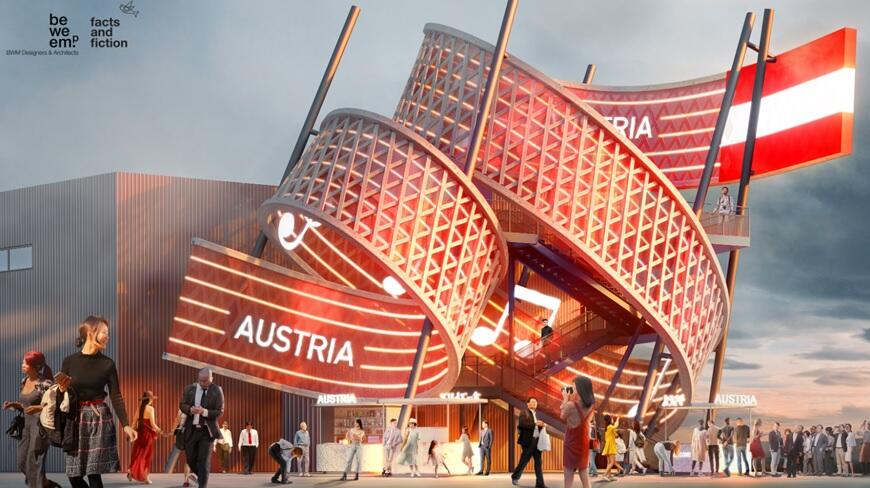
(Photo courtesy of Expo Austria/BWM Designers & Architects)
Provided by Kyodo News
Canada's ice-inspired pavilion to welcome visitors with "warmth"
Canada's pavilion at the 2025 World Expo may appear icy with its sharply angled white exterior, but the country aims to offer visitors a warm experience by showcasing its openness, cultural diversity and other attributes.
The pavilion's exterior architecture represents a natural phenomenon seen in Canada called an "ice jam," which occurs when river ice melts and flows at the onset of spring, a long-awaited season in the country where winter temperatures can fall below minus 50 C.
"Canada's theme is regeneration," Laurie Peters, commissioner general for Canada at the expo, said in a recent interview, explaining that the intention is partly to present a "renewed" image of her country beyond its well-known natural wonders such as Niagara Falls and the Rocky Mountains.
"Many people know and love Canada for its nature and natural beauty...but they perhaps don't know as much about Canada's creativity and diversity and commitment to sustainability," she said.
Canada, built by immigrants from around the world, has actively promoted inclusion and respect for diversity, with its multicultural society made up of three founding peoples — aboriginal, French and British — and a rich tapestry of other racial and ethnic groups.
English and French are both used as Canada's official languages. In 1988, the country became the first in the world to enshrine its multiculturalism policy in legislation.
During the expo, visitors will be offered an "analog experience" at a time when many things can be enjoyed virtually, Peters said, touching on music and other cultural performances and culinary programs that will bring chefs from Canada to serve local dishes and food ranging from lobster and beef to blueberries to maple syrup.
Actual interactions with Canadians will also be a highlight, with some 30 young people recruited to come to the Asian country. They are expected to speak English, French and Japanese to welcome and guide the guests.
The expo will be a "perfect extension" of the deep and longstanding relationship between Canada and Japan, Peters said.
Canada is also a popular destination for Japanese students attending universities and other schools to go abroad for study, ranking second after the United States in fiscal 2022 in terms of the number of students at more than 6,700, according to data from the Japan Student Services Organization.
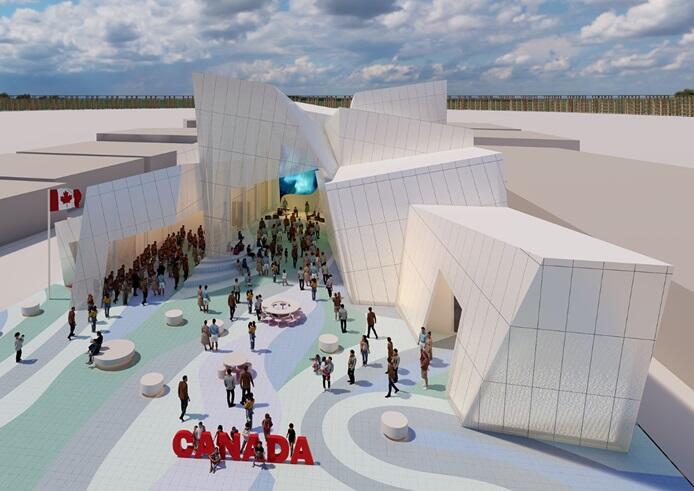
(Photo courtesy of the Canada Pavilion)
Provided by Kyodo News
China embraces bamboo-inspired minimalism for expo pavilion
Although commonly associated with bold and vibrant aesthetics, China appears to have chosen a more sleek, minimalistic look for its pavilion at the 2025 World Expo.
Dubbed the "inscribed slips of China," the architectural design of the pavilion is inspired by traditional bamboo slip scrolls used for writing on in ancient times.
The combination of bamboo, scrolls and Chinese characters showcase the spiritual and cultural essence of Chinese civilization, while also embodying the country's commitment to green development in the new era, according to the China Council for the Promotion of International Trade.
The pavilion will accentuate the Chinese philosophy of living in harmony with nature, aligning with its theme of "Building a Community of Life for Man and Nature — Future Society of Green Development."
Gaps in the facade designed to resemble those in an ancient bamboo scroll will allow sunlight to filter through to provide natural light to the inside.
The motif continues into the interior, where the layered exhibition space symbolizes the evolution of civilization from past to future.
"We will endeavor to make the pavilion the most dazzling business card for China," Ren Hongbin, the council's chairman, said at the groundbreaking ceremony held at the expo's venue on Yumeshima, an artificial island in Osaka Bay, in February.
Osaka Gov. Hirofumi Yoshimura said at the ceremony, "I am confident that the China Pavilion at the Osaka expo will act as the starting point for deepened bonds of friendship between Japan and China."
One of the largest self-built pavilions with an area of around 3,500 square meters, the China Pavilion will be positioned near the center of the Grand Ring, a ring-shaped wooden symbol of the expo with an expected circumference of around 2 kilometers.
At the Shanghai Expo in 2010, China's pavilion, dubbed the "oriental crown," featured a red exterior that blazed in the skyline of the venue.
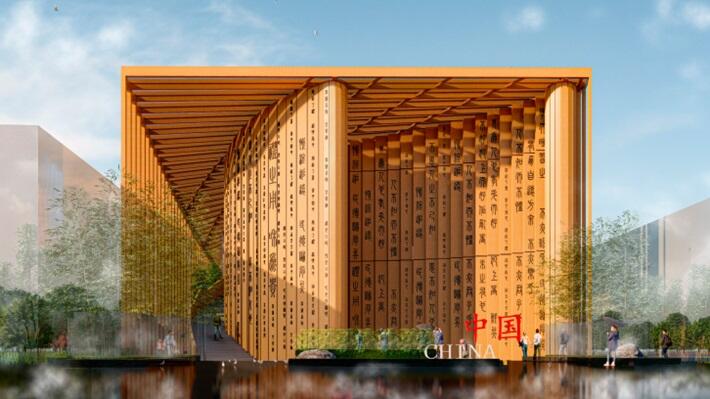
Provided by Kyodo News
Germany's expo pavilion to shape around theme of "circular" world
Germany, known for beer, sausages and famous philosophers such as Karl Marx and Friedrich Nietzsche, aims to wow visitors at the 2025 World Expo with a fresh focus on a circular economy and sustainability.
Featuring seven circular wooden buildings made of reusable materials, the pavilion is named "Wa! Germany."
The word "wa" means "circle" in Japanese and also carries connotations such as "harmony," in this case between nature and technology, which is the objective of a circular economy. But the word is also meant to suggest an enthusiastic "wow."
Visitors will be greeted by a round-shaped original mascot called Circular inspired by Japan's "kawaii" (cute) culture. A palm-sized version of Circular, which serves as an audio guide, will help guests navigate the pavilion.
The pavilion will minimize the use of resources in construction and employ reusable materials, along with smart climate control systems and greenery space, aiming to present solutions for creating a circular society where economic activities coexist with nature.
"Everything is based on the idea of circularity or — translated into design terms — on the shape of the circle: the pavilion itself, the visitor experience, the design, the technologies presented and visions of the future," Andreas Horbelt, creative director of facts and fiction, an agency responsible for the exhibition design, said in its website.
"Visitors to the exhibition embark on an emotional and multi-sensory journey in which they discover tangible visions of life in a circular society," the website also said.
In addition to the exhibition zone, the pavilion will have a restaurant named "Oishii! Germany," where visitors can enjoy currywurst, a popular street food in Berlin, and traditional beef stew. "Oishii" means "delicious" in Japanese.
Souvenir shop "Omiyage! Germany" is likely to sell items such as beer mugs and Christmas ornaments.
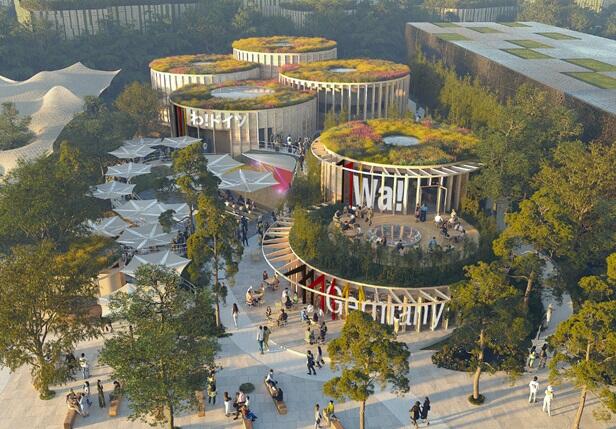
(Copyright MIR_LAVA_facts and fiction)
Provided by Kyodo News
S. Korea's pavilion to feature giant screen for K-pop videos
With the global Hallyu wave captivating audiences through music, drama and fashion, South Korea's pavilion at the 2025 World Expo will feature a giant screen displaying K-pop videos and showcase the country's cutting-edge technology.
Under the theme "With Hearts," the pavilion, one of the largest self-built overseas pavilions at the expo, aims to connect visitors' hearts through exhibitions blending traditional and modern Korean culture.
The large screen will be installed on the pavilion's exterior, utilizing so-called media facade technology that employs multiple light sources to create dynamic visual displays.
The screen can also be viewed from a nearby rooftop of the expo site's symbolic wooden structure dubbed the Grand Ring, which will serve as the main circulation path for the international fair.
Visitors will also have a chance to experience Korean culture and enjoy traditional Korean cuisine at a restaurant.
The pavilion will have three main halls, one intended to immerse visitors with sound and light using artificial intelligence and another creating a terrarium space to learn about South Korea's efforts to tackle global warming and other environmental issues.
In the other hall, visitors will experience what a future society made up of advanced technology will look like utilizing multiple screens.
"We will showcase a unique pavilion that will merge South Korean tradition and culture," Yu Jeoung Yeol, president and CEO of Korea Trade-Investment Promotion Agency, said at the groundbreaking ceremony held at the expo's venue on Yumeshima, an artificial island in Osaka Bay, in February.
As 2025 marks the 60th anniversary of the normalization of diplomatic relations between South Korea and Japan, Yu also said, "It is a highly significant year. Our participation in the expo will further strengthen the relationship between our two countries."
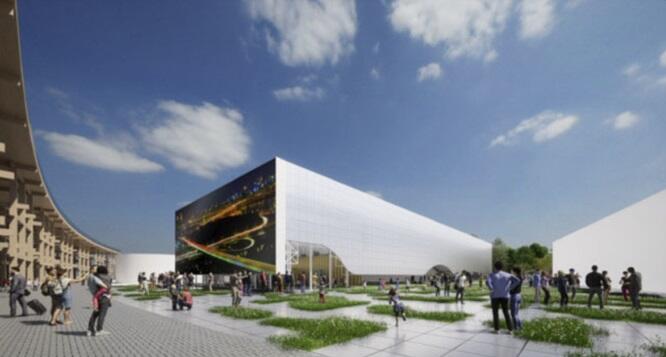
(Photo courtesy of the Korea Trade-Investment Promotion Agency)
Provided by Kyodo News
Switzerland's pavilion of recyclable spheres to be its "lightest ever"
Switzerland says its pavilion for the 2025 World Expo is set to be its "lightest ever," and will feature four interconnected spheres made of special film showcasing robotics and other innovative technologies.
With the hope that the pavilion structure will create a magical atmosphere, visitors will be welcomed by an area designed to recreate the nature of the Swiss Alps. There will be different touchpoints involving the world of Heidi, a children's novel about the life of a girl in the Alps, as a feature throughout the pavilion, the organizer said.
Switzerland's pavilion is expected to produce the "smallest ecological footprint" ever for the country at the event thanks to the use of very light membrane material made from a durable, fluorine-based plastic film known as ETFE for the spheres.
The material that will form the spheres' surfaces is recyclable and will be made into furniture after the expo, weighing about 450 kilograms in total.
Switzerland's exhibition will focus on three themes during the expo period. "Augmented Human" features robotics and artificial intelligence and will run from April 13 to June 4. "Life" looks at life sciences, education, and nutrition, and will feature from June 5 to Aug. 12, while "Planet" will focus on the environment and sustainability from Aug. 13 to Oct. 13.
A souvenir shop offering goods such as wooden toys will also be set up, while coffee, croissants, bubble tea, ice cream and other food and drinks will be available at its rooftop bar overlooking the pavilion.
The organizer said it expects around 1.5 million visitors to the pavilion.
Switzerland's participation in the expo represents "a major opportunity" to strengthen bilateral ties with Japan, as 2024 marks the 160th anniversary of the establishment of diplomatic relations, brought about by the pioneering spirit of Swiss watchmakers seeking trade with Japan, according to the Swiss government.
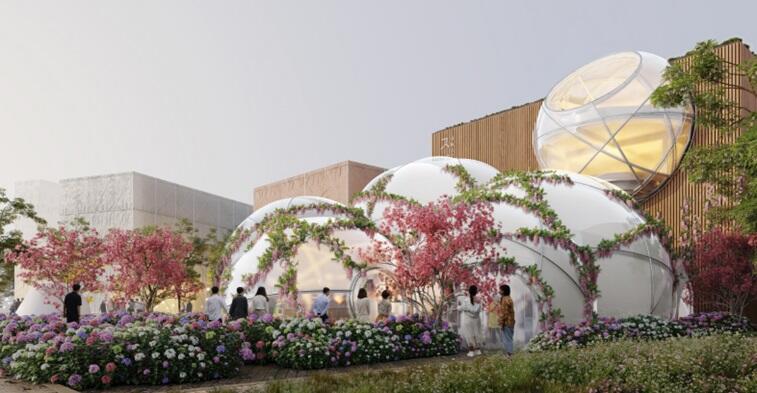
(Copyright Presence Switzerland)
Provided by Kyodo News
U.S. to immerse expo pavilion visitors in culture, space exhibits
The U.S. pavilion in the 2025 World Expo aims to immerse visitors in exhibits representing what the country calls "the best of America," ranging from culture and education to space exploration.
The pavilion's exterior adopts a minimalist design inspired by the Japanese traditional aesthetic of "wabi-sabi," featuring two triangular buildings with wooden facades juxtaposed by an illuminated, suspended cube.
Under the cube, visitors will find an open-air courtyard with a performance stage, allowing them to explore music, dance and other entertainment, as well as cuisine. Images to be shown at the pavilion are expected to include U.S. landmarks such as the Golden Gate Bridge and the Grand Canyon.
With the theme "Imagine What We Can Create Together," visitors can enjoy envisioning themselves studying at prestigious universities, touring various parts of the country and appreciating its natural beauty, and joining a space journey to the Moon and beyond.
The pavilion will serve as "an immersive cultural bridge," said Trey Trahan, founder and CEO of Trahan Architects, which led the architectural design of the building.
The United States has a long history of participating in the World Expo dating back to the 19th century, viewing the global event as an opportunity to showcase American values, culture and global leadership.
The hamburger is said to have been popularized at the 1893 Chicago expo, and radiophone, invented by Alexander Graham Bell, made its public debut at the St. Louis fair in 1904, according to the U.S. Embassy in Tokyo.
The star attraction of the U.S. pavilion in 1970, the first time the expo was held in Osaka Prefecture in western Japan, was a Moon rock retrieved in the Apollo 12 mission, according to the National Aeronautics and Space Administration.
Ambitious space endeavors will again be a highlight in the upcoming expo, with exhibitions likely to include images from NASA's James Webb Space Telescope, launched in 2021 as the largest and most powerful telescope ever, according to a U.S. government official.
The United States is aiming to return humans to the Moon for the first time since the Apollo 17 lunar landing mission in 1972, as part of its Artemis program that also involves Japan.
The pavilion will utilize reused steel, tensile fabric and other materials from disassembled structures from the Tokyo Olympics held in 2021 and other events. After the close of expo, the materials are expected to be recycled for use at future events.
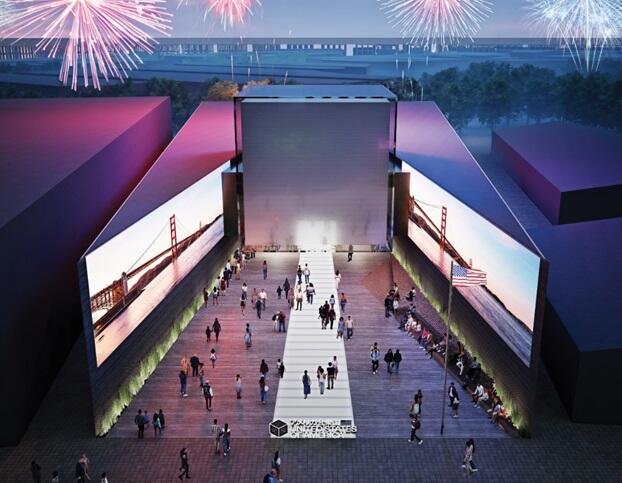
(Photo courtesy of Trahan Architects)
Provided by Kyodo News




